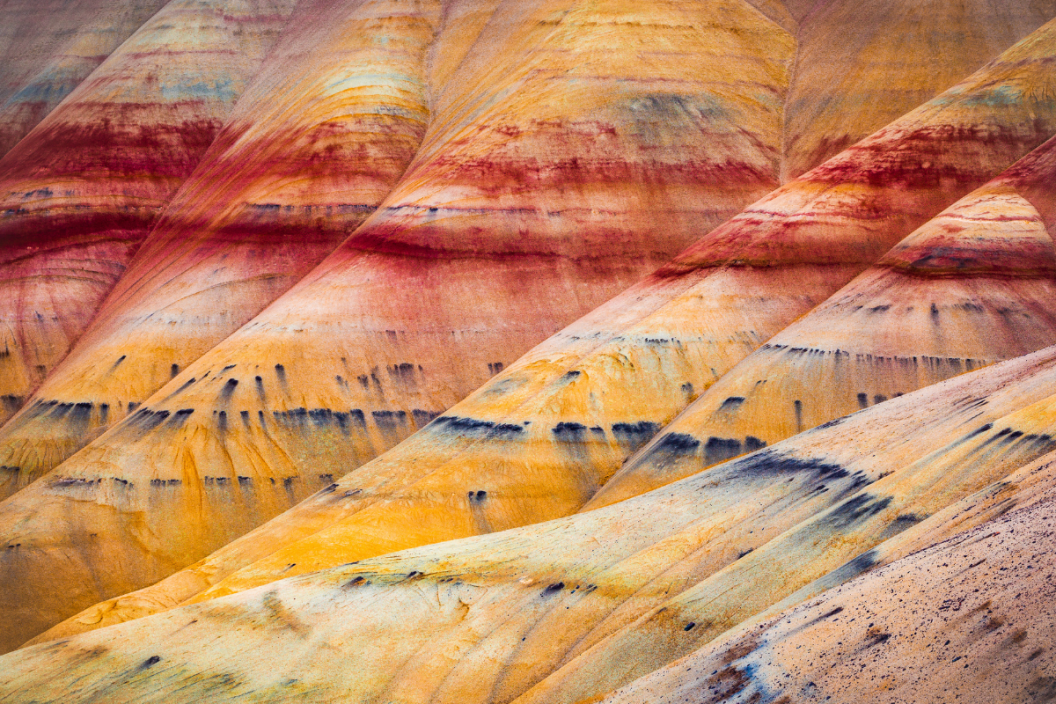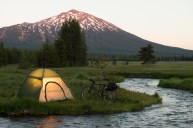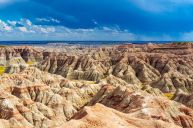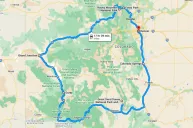When people think of Oregon, they mostly picture snowcapped mountains, forests full of Douglas firs, and the endless buckets of rain falling in Portland.
But what many don't realize is that about a third of this Pacific Northwest state is covered with high desert. Starting in Central Oregon, travelers can visit breathtaking rock formations and other sublime sights on par with famous national parks like Death Valley and Red Rocks.
Chief among these wonders is the John Day Fossil Beds National Monument, which includes the Painted Hills Unit, the Sheep Rock Unit, and the Clarno Unit.
Camping Near John Day Fossil Beds
https://www.instagram.com/p/B7YtzUkny5l/
Unfortunately, there are no camping areas located in any of the three sections of this national park. However, there are quite a few sites around the region that have everything from cabins to RV hookups. Your options include state, federal, and private grounds, all of which charge various fees and offer different features.
A simple internet search can get you better details and help you find the right camp to make your trip a success. But be sure to book your spot well in advance, as Oregon campsites are notorious for selling out way ahead of the busy season.
Visiting This National Park
https://www.instagram.com/p/CIvzv3JloWm/
As mentioned above, unlike your average national park, the John Day Fossil Beds National Monument is broken up into three locations, all of which can be accessed by highway. If you start around the Bend area and head out along highway 26, the pull off for Painted Hills comes just before the city of Mitchell. Go a bit further and you'll find the Sheep Rock Unit where the 26 meets highway 19, west of Dayville.
For better or worse, the Clarno Unit is a little more remote than the other two sites, so keep in mind that whatever highway you use to reach it could seriously alter your itinerary.
While each of the units that make up the monument have their own hiking trails, majestic palisades, and the sort of fossils that make paleontologists' eyes pop out, it takes hours to get around to each one. As such, don't expect to do it all in a one day round-trip if you want to get the most from your experience.
Jurassic and Cretaceous Park
https://www.instagram.com/p/CM5bdi1sC2x/
RELATED: Top 15 Best Places To Travel In July In The U.S.
At over 14,000 acres, every section of the park is situated among what are known as the Blue Mountains. This geographic region was formed around 100 million years ago and later inhabited by dinosaurs, giant sloths, and other ancient beasts.
For centuries, the only humans to live in this central stretch were the native tribes that still call it home today. It wasn't until the mid 19th century that geologist Thomas Condon brought the fossil beds to the attention of serious paleontologists.
Although the Lewis and Clark expedition caught wind of the area in 1805, they continued west without stopping to take in the sights. The Oregon Trail video game series is sadder for it.
Three's a Crowd
https://www.instagram.com/p/B_3ajyOBP8M/
Here are some facts about all three units to consider when planning your trip:
Painted Hills Unit: Perhaps the most stunning of the three, the Painted Hills features exposed cross sections of colorful rock and claystone complexes that can easily be explored thanks to a collection of short trails and boardwalks.
Sheep Rock Unit: With two highways running right through it, Sheep Rock is probably the easiest part of the monument to access. Its historic James Cant Ranch House and Thomas Condon Paleontology Center give it an entertainingly educational advantage over the other locations.
Clarno Unit: Located just east of the John Day River on highway 218, serious hikers will prefer the scenic views this isolated tract has to offer, including popular treks like its Trail of Fossils and Geologic Time Trail.
Pro Tips for Rural Oregon Travel
https://www.instagram.com/p/0p63XIwUK7/
John Day, John Day, or John Day?
In addition to the three sections that make up the John Day Fossil Beds National Monument, there's also the John Day River and the city of John Day. So, if you want to have a good day out on the road, be sure to double check your GPS coordinates so you don't end up heading to the wrong place. Not that we would know from experience...
Last Gas for Miles
If you're making your way from one part of the national park to another, be sure to fill up every time you come across an open station. Like it or not, the high desert in Eastern Oregon is no friend to low gas tanks. You'd think with all the fossils laying around fuel wouldn't be an issue, but it turns out rural Oregon is a bit of a gas desert too.
Wave of the Past
Don't be surprised if you see oncoming drivers waving "hello" at you while you're making your way down the 26, 19, and other remote stretches of rural Oregon highway. They aren't trying to flag you down because your car's on fire or anything like that — it's just the friendly way the locals are. Next to beautiful geology, this is the second most impressive thing you'll regularly come across in Eastern Oregon.
Always Be Prepared
While the different units of the monument have things like parking lots, picnic areas, and other modern facilities, they're each separated by miles of open country and there are few small cities between. Just so, consider packing first aid supplies and a survival kit in addition to the usual suspects like plenty of water, nutritious snacks, and multiples layers of clothing. After all, there are easily more rattlesnakes in Oregon than there are medivac helicopters.
Have you ever camped near the John Day area? Tell others where the best spots are on Wide Open Roads Facebook!




